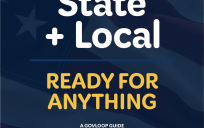This week, HIMSS11 took place in Orlando, Florida. The state and local government market was atwitter with health IT, electronic health records, health information exchanges and one thing many vendors interested in the health insurance market will be watching is an announcement today by HHS’s consumer information and insurance head, Steve Larsen.
Today is the last day of the HIMSS 2011 annual conference and exhibition. Formally known as the Health Information Management Systems Society, but pronounced similarly to the word hymns for short, the group has been fervently writing the gospel of health IT over the last few years as billions of federal dollars are waved in front of practitioners to implement electronic health records (EHRs) and generally bring the health care world into the 21st century.
Just about every major Health IT vendor, as well as new and old government contractors alike, released a flurry of new products and announced new partnerships. Health information exchanges (HIEs) and mobile solutions were the rage at HIMSS 2011, but it would be foolhardy to mention every major (and want-to-be major) announcement from HIMSS, so we’ll cherry pick a few that have some relevance to state and local government:
Both IBM and CSC announced new partnerships with leading universities this week. This Tuesday IBM announced that it was going to join UNC Health Care in launching a new health information exchange (HIE). The new UNC Health Care HIE is expected to be among the most advanced in the nation, creating a model for the rest of North Carolina as well as other states, IBM said. Big Blue also announced that it is creating a new healthcare interoperability lab in Chicago that will allow IBM Business Partners to “design, develop, install and test the latest healthcare technologies built on the IBM Health Integration Framework.” IBM will look to expand its consulting practice and strategic planning for HIEs, as well as help educate and train health care professionals as part of this interop lab.
CSC, meanwhile, announced that a partnership with Kansas University has delivered a software tool that provides real-time clinical surveillance and reporting for hospitals by continuously monitoring and evaluating clinical information generated during patient care. Dubbed CareVeillance, the software “integrates patient data from disparate systems, analyzes and connects this information, and displays consolidated clinical data focused on the specific condition found.” CSC says that unlike existing EHR and data warehouse systems, CareVeillance examines new data about the patient and compares it, using complex clinical algorithms, to existing data to identify conditions requiring investigation or intervention.
Oracle announced new “security” and “interoperability” enhancements to its Oracle Health Information Exchange this past Monday. In standard no-nonsense fashion, the company laid out the improvements in bullet-point fashion saying the new HIE includes:
- Oracle Health Sciences Information Gateway, which enables secure, policy-based communications over the Internet to safeguard in-transit Protected Health Information;
- Oracle Healthcare Master Person Index to provide a single point of reference to information about a patient, clinician, or other entity within a healthcare organization or health information exchange; and
- Oracle Health Sciences Information Manager to improve data accuracy, simplify data management, increase security and provide information access auditing for regulatory compliance;
Last, but certainly not least, Steve Larsen, Director of the Center for Consumer Information and Insurance Oversight announced today that HHS is handing out nearly $200 million in new grant funds for states to strengthen their programs for reviewing health insurance premium increases.
According to a blog posting by Mr. Larsen, the new funds will help states meet recently proposed requirements for an effective rate review program:
Under the proposed regulation, an effective rate review program would also include an infrastructure to collect, analyze, and report critical information about rate review outcomes and trends, including whether or not proposed rate increases have been approved, if State law provides authority to disapprove rates.
Some market forecasts predict nearly $600 million would be up for grabs from state and local governments to help set up health insurance exchanges. But this represents only a small fraction of what some estimates say will be a $4 billion per year exchange industry. The opportunity announcement indicates that there will be an expected 56 grants handed out with award ceilings of $3,000,000. To read more about the new grant program, click here.
Have a contract win or deal you’d like to see in the SLG Business Brief? Please let us know by emailing CivSource {at} CivSourceonline {dot} com. The CivSource SLG Business Brief is a weekly roundup of state and local contract wins and product releases within the wide world of government technology.





Leave a Reply
You must be logged in to post a comment.